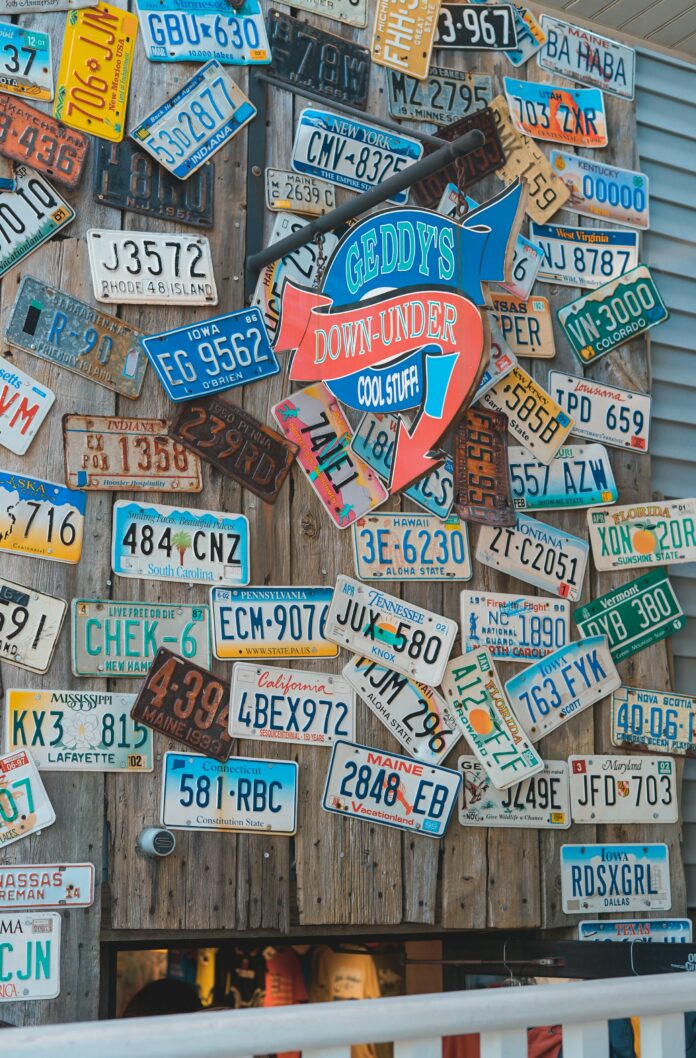The numbers and letters on your car can reveal more than you think
By ELI KELLEY — arts@theaggie.org
Countless groups are devoted to the identification and classification of the natural world. Birds, butterflies and beetles have occupied uncountable hours of hobbyist attention. In cities, options for wildlife enthusiasts are more limited. Though natural fauna has been expelled from many city streets, we’ve constructed strange beasts of our own with a variety that challenges even the beetle. While bird watchers and beetle catchers may be hard-pressed to pursue their interests in these urban circumstances, there’s another kind of creature that’s equally deserving of study. The curious and the perceptive can find a great deal of interest and pleasure in examining the most ever-present of our urban beasts: the automobile.
Among all vehicles, license plates are the feature that unites them as both unique and of a kind. They’re the DNA of motor vehicles; no two are the same, even as they share a common structure and design. For anyone interested in the dizzying variety of plates out there, this guide will serve as a primer to the license plates you’re likely to see both around Davis and beyond.
With the exception of custom license plates, all California license plates have a structure to them. A skilled observer can discern a surprising amount from a car’s plates. For instance, license plates are made sequentially. The plate printed after “3XYZ891” will read “3XYZ892.” This can let you know how long ago a car was registered. For instance, the first plate printed using California’s current design for standard license plates was “1AAA000.” That was in 1980. As of early 2024, a plate was printed that read “9KVY267.” The first digit is an easy way to tell approximately when a car was registered.
Since no two plates are the same, a nine being in the first position suggests that we’re running out of possible license plates of that format. Once the current well of possibilities runs dry, likely a new format will be chosen and the process will start anew.
A perceptive reader may have noticed a reference to “standard” license plates (and congratulations to that reader — their car-watching journey is off to a good start). Most cars share that format of one number followed by three letters followed by three numbers. An experienced observer, however, will spot other formations.
One example is vehicles registered for commercial use — this usually means large trucks and vans, but also includes some pickup trucks whose owners discovered that commercial plates allow them to park in “commercial only” parking spots. Recently commercial plates took a format that began with the plate “1A00000.” Since commercial plates have two more digits and two less letters relative to standard plates, there are far fewer possible commercial plates (because there are 24 letters and only 10 digits). This led to a shortage of plates, and now commercial plates take the form of “10000A0.”
Running out of plate combinations is a common occurrence. This is especially true for plates made for permanently disabled persons, which have in total only five digits and letters. The format for these plates has changed many times in even just the past few decades. Despite the variety of forms that disabled persons (DP) license plates can take, they’re easily identifiable by the common white and blue “disabled sign” of the figure in a wheelchair. These plates also have in small letters next to the main text of the license plate the letters “DP.” There are also disabled veterans plates that look similar and have the letters “DV.” Some forms these plates have taken over the years include “00001(DP),” “(DP)00001,” “(DP)A0001,” “0001A(DP),” “(DP)001AA” and “AA001(DP).”
License plates can take many forms. Some are common. Others are deeply obscure. The selection referenced here is nowhere near a comprehensive guide. But, the fact that it can’t be serves as a testament to one of the core joys of watching license plates: it’s never finished. There are always different and new formats whose purpose can be deduced. There are always surprising combinations of letters and numbers to be found. For better or for worse, cars are a given nearly anywhere you go. Why not then look for the beauty in this system whose reach touches so many areas of modern life?
Written by: Eli Kelley — arts@theaggie.org





